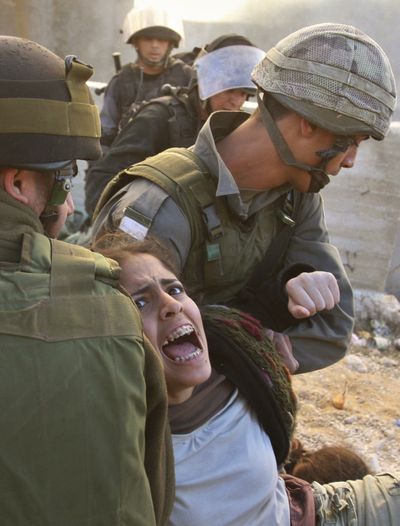Israelis get tough on settlement
Disputed West Bank building held 250 Jewish extremists

HEBRON, West Bank – Israel took its strongest action against Jewish settlers in nearly three years Thursday as riot police stormed a disputed building in Hebron, using tear gas and stun grenades to force out 250 young extremists bent on expanded Israeli occupation of the West Bank.
After losing a swift afternoon battle, settlers struck back into the night with gunfire and arson attacks on Palestinians in this flash-point city and other parts of the West Bank, raising tensions between Israel and the Palestinian Authority.
Seventeen Palestinians were wounded along with at least 35 Israeli soldiers, police officers and settlers. Fires blazed after dusk along a ravine dividing Hebron, a largely Palestinian city, and the Jewish settlement of Kiryat Arba as police skirmished with settlers on both sides.
Israel’s tolerance of settlement growth has been an obstacle to progress in American-brokered Israeli-Palestinian peace talks over the past year. But Thursday’s raid stemmed mainly from pressures within Israel’s legal and political systems.
“What was put to the test today was the state’s ability to enforce the law and its will on its citizens,” said Israeli Defense Minister Ehud Barak, who ordered the raid in belated response to a Supreme Court order.
About 250,000 Jewish settlers live among 1.8 million Palestinians in the West Bank, which Israel captured in the 1967 Middle East War. They coexist most intimately in and around Hebron, a city that is holy to Jews and Muslims. Alongside the 170,000 Palestinians live nearly 8,000 religious-driven settlers who regard the entire West Bank as land God gave the Jews.
Much of the world considers the settlements illegal. But for decades, Israel has treated their occupants as brave pioneers. It formally supports the bulk of the settlements, even while accepting the Palestinians’ demand to recover the West Bank and Gaza Strip as part of the agenda for peace talks.
Israel withdrew its settlers from Gaza in 2005. But it has resisted U.S. pressure to halt expansion of suburban-style settlements across the West Bank and shied away from evicting settlers from the 100 or so rudimentary outposts it does not formally authorize.
The target of Thursday’s raid, a four-story stone house on the Hebron side of the ravine, has been contested since March 2007 when settlers claiming to have purchased it moved in. The acquisition was part of a plan to establish a Jewish presence in a corridor linking Kiryat Arba’s 7,000 Jews with a settlement of 700 in the heart of Hebron.
Faiz Rajabi, a Palestinian, said the building belongs to him and denies having sold it to the settlers.
As the case went to court last year, the number of Jewish occupants grew to about 150, including families with children. They called the place “House of Peace” and defied a string of government eviction orders. The Supreme Court forced the issue on Nov. 16 by ordering the government to take custody of the building until Israel’s legal system completes a lengthy process of resolving the ownership dispute.
Barak met Thursday with the moderate Yesha Council, which tried to mediate between the government and the militants in Hebron. They failed to reach an agreement, but the council’s leaders left the meeting believing one was still possible. A tense state of alert among settlers at the contested house eased.
Seizing the advantage of surprise, 600 police and army soldiers moved in three hours later and ringed the house. About 100 police officers stormed all entrances, filling the house with tear gas.
Less than an hour later, police were in full control of the house. Many of the settlers had left voluntarily. Others had been carried out one by one, their hands and legs held by teams of police officers. Soldiers and police officers also formed a human chain, blocking several attempts by the settlers to re-enter.